.svg)
Please note that 'Variables' are now called 'Fields' in Landbot's platform.
With the expanding features and capabilities of WhatsApp Business API Platforms and the generative AI boom, more and more go-to-market team leaders and business managers are opting to create WhatsApp bots to communicate with their customer base in 2025.
If you, too, are looking to learn more about how to create a chatbot in WhatsApp, you have come to the right place. This article outlines how to build a chatbot solution for WhatsApp using both Landbot’s drag-and-drop builder and one of its AI Assistants — all while making the best use of WhatsApp automation.
So, without further ado, let’s see what it takes to build a WhatsApp chatbot for your business with Landbot.
What is a WhatsApp Bot?
A WhatsApp bot provides your leads and/or customers with a real-time automated conversational experience directly on the messaging app.
The key advantages of creating a WhatsApp chatbot include:
- Instant communication: Being able to communicate with the audience instantly, without delay, because people check WhatsApp more frequently than email marketing messages.
- Asynchronous communication: In other words, you can reply instantly, the customer can stop and restart the conversation at their own convenience, and the thread will never be lost.
- Customers’ WhatsApp usage: WhatsApp allows you to get in touch with your target audience without forcing them out of their comfort zone (via a messaging platform they use daily).
- Personalized experience: WhatsApp chatbots deliver personalized messages with every interaction, thanks to accurate user history and data collection.
A WhatsApp chatbot or AI assistant can be used for a variety of use cases across customer journeys and is a powerful tool that helps go-to-market teams with marketing campaigns, sales automation, customer support and success, and more!
Who Can Build WhatsApp Bots?
Anyone with a WhatsApp Business Profile who has applied and been approved for the WhatsApp Business API.
As you’ll see in the step-by-step below, businesses and go-to-market team leaders alike can easily learn how to create a WhatsApp chatbot, and so, are starting to take advantage of the possibilities that come with WhatsApp.
Still, even though WhatsApp has opened its doors to business communications, the API integration is not available to just anyone.
Before you can create a WhatsApp chatbot, you need to:
- Go through the API application process: WhatsApp prioritizes medium, large, and enterprise businesses in selected industries.
- Review WhatsApp Commerce Policy: This way, you’ll ensure your industry and/or use case doesn’t breach any of the imposed regulations.
- Activate your WhatsApp phone number: Once your application is approved, you will need to activate an existing or new phone number to use with your WhatsApp Business Account.
How to Build a WhatsApp Bot with Landbot's No-Code Builder
If you're in a hurry, you can get a good idea of what steps you need to take to create and test your bot in the video below. Though for a more detailed guide, follow this tutorial to the end.
For a complete video guide to building WhatsApp chatbots, visit our free course at Landbot Academy. This tutorial takes you through no-code chatbot creation and explains how to create a rule-based WhatsApp chatbot using a decision-tree-like structure powered by integrations. However, if you are more interested in AI chatbots, you can jump ahead to the next section, where we cover building WhatsApp bots with our AI Agent.
1. Set Up WhatsApp Bot Canvas
To set up your canvas, navigate from the home screen to the “Bot builder” by clicking on the bot icon in the navigation bar on the left:

Once there, simply click on the “Build a chatbot” button in the upper right corner and select WhatsApp as the channel. You will be asked to choose between using the “Build it for me” feature, “Start from scratch”, or “Use a template”. We encourage you to try out the feature and browse through our template library, but for this tutorial, let’s go with the “Start from scratch” option.
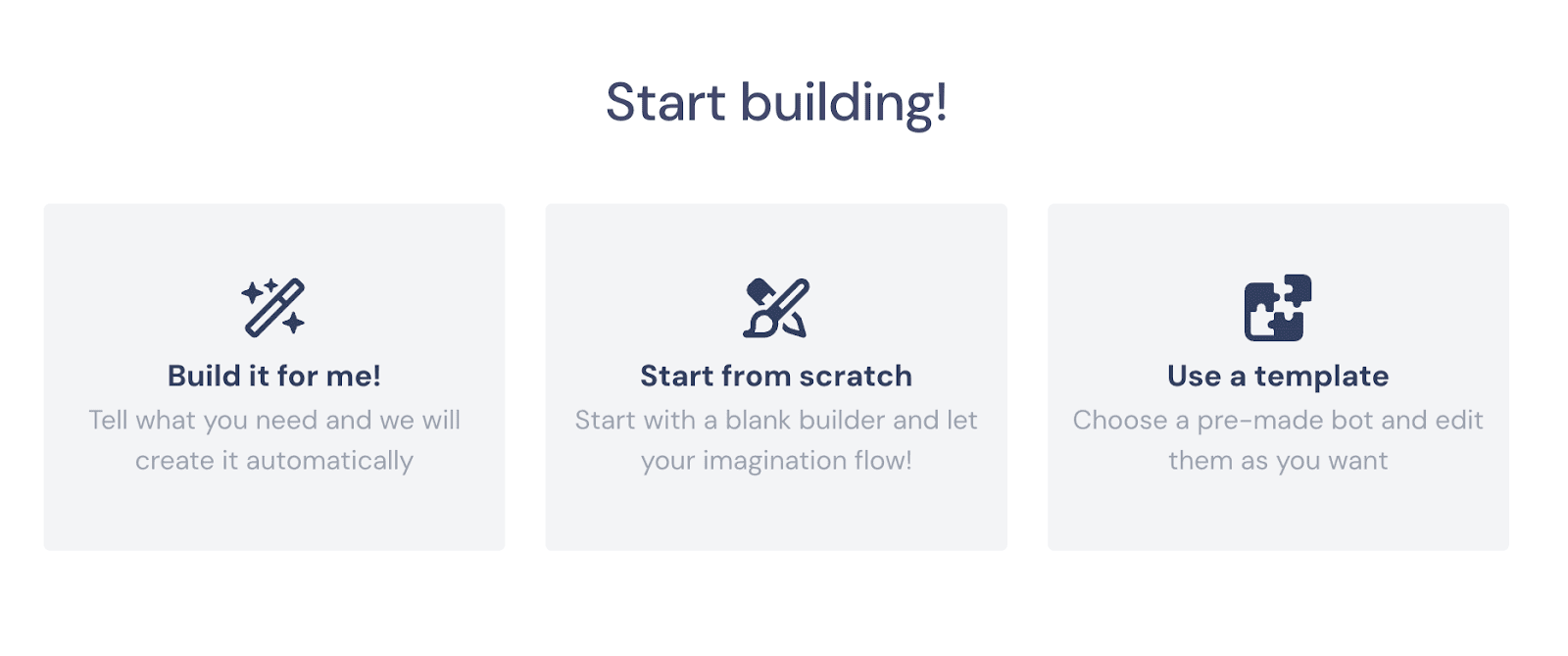
2. Create Your First Block
When you first access the chatbot builder, you will notice the “Starting point” block, from which you can drag and drop an arrow to add your first block.
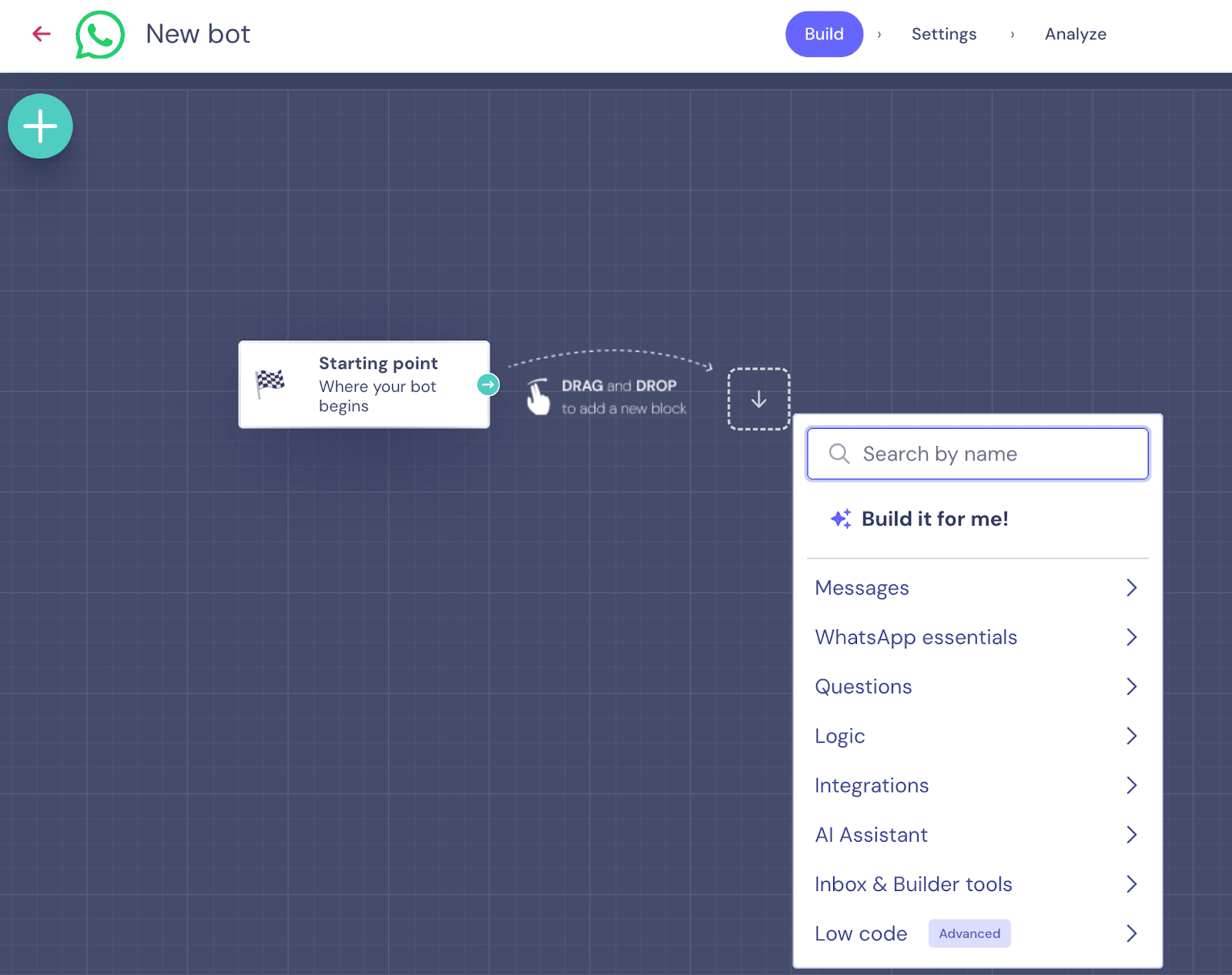
We will start by adding a “Collect intent” block. The Collect intent block is an extremely useful tool that helps capture and store your user's first interaction with your bot and—if you wish— already use that input to start personalizing the conversation.
By default, the user's first input to the chatbot will be saved in the string Field @user_input. However, you can change the name and format of this Field to fit your purposes.
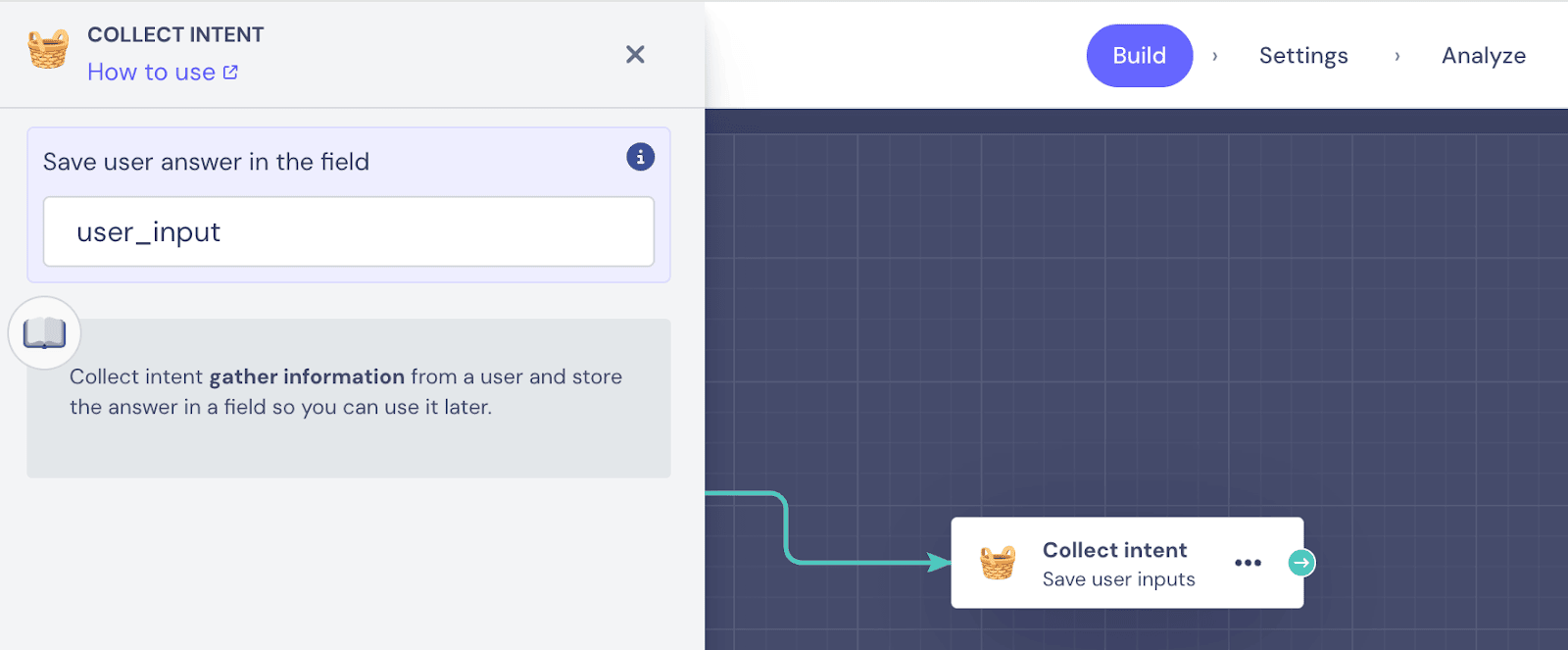
This user intent can be unprompted (the user reaches out to you with their own agenda) or inspired by a template message notification that encourages the user action.
How does this help with personalization?
Well, for example, you can follow up this block with the Keyword Jump block. It will look like this:
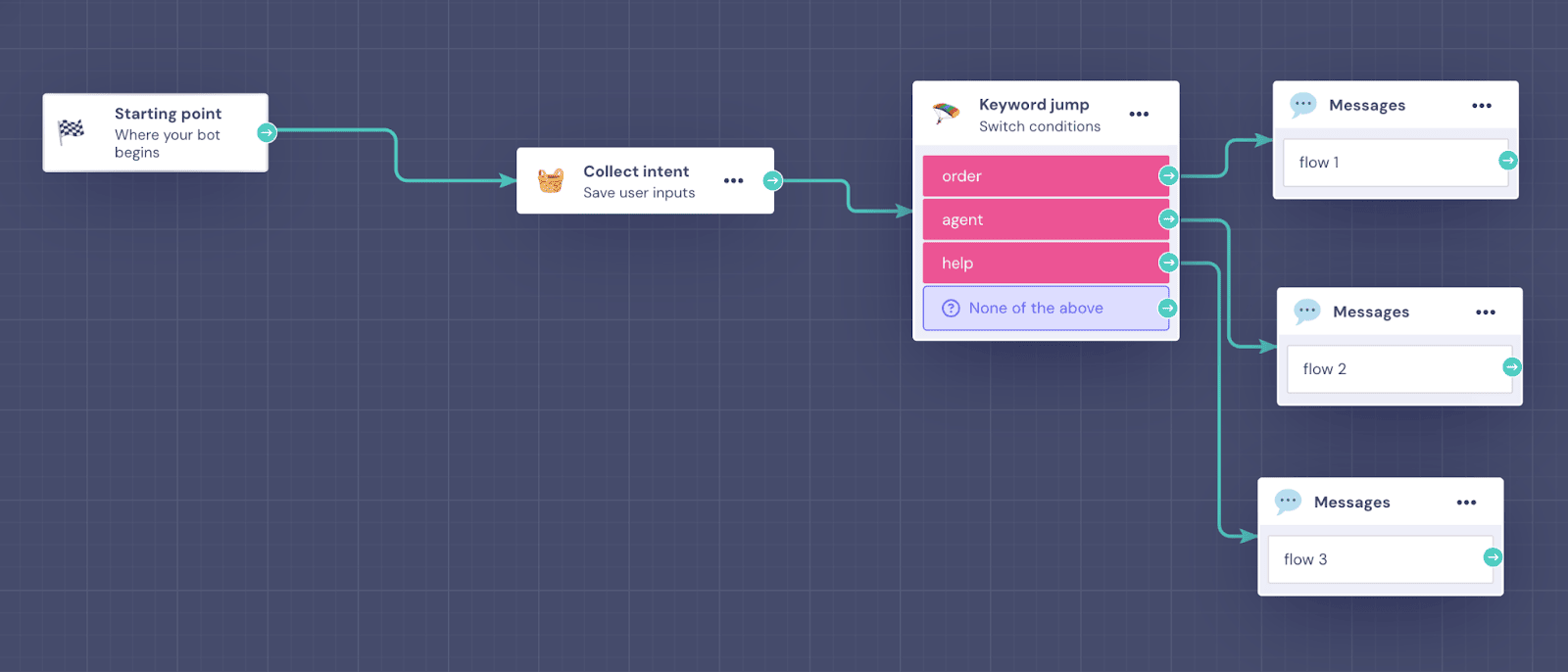
Using this block is best if the user input is in response to a template message that offers a “menu” of responses, be it buttons or text options.
You can also use the Conditional Logic block, which allows you to check if the input contains specific words that help you understand the request.
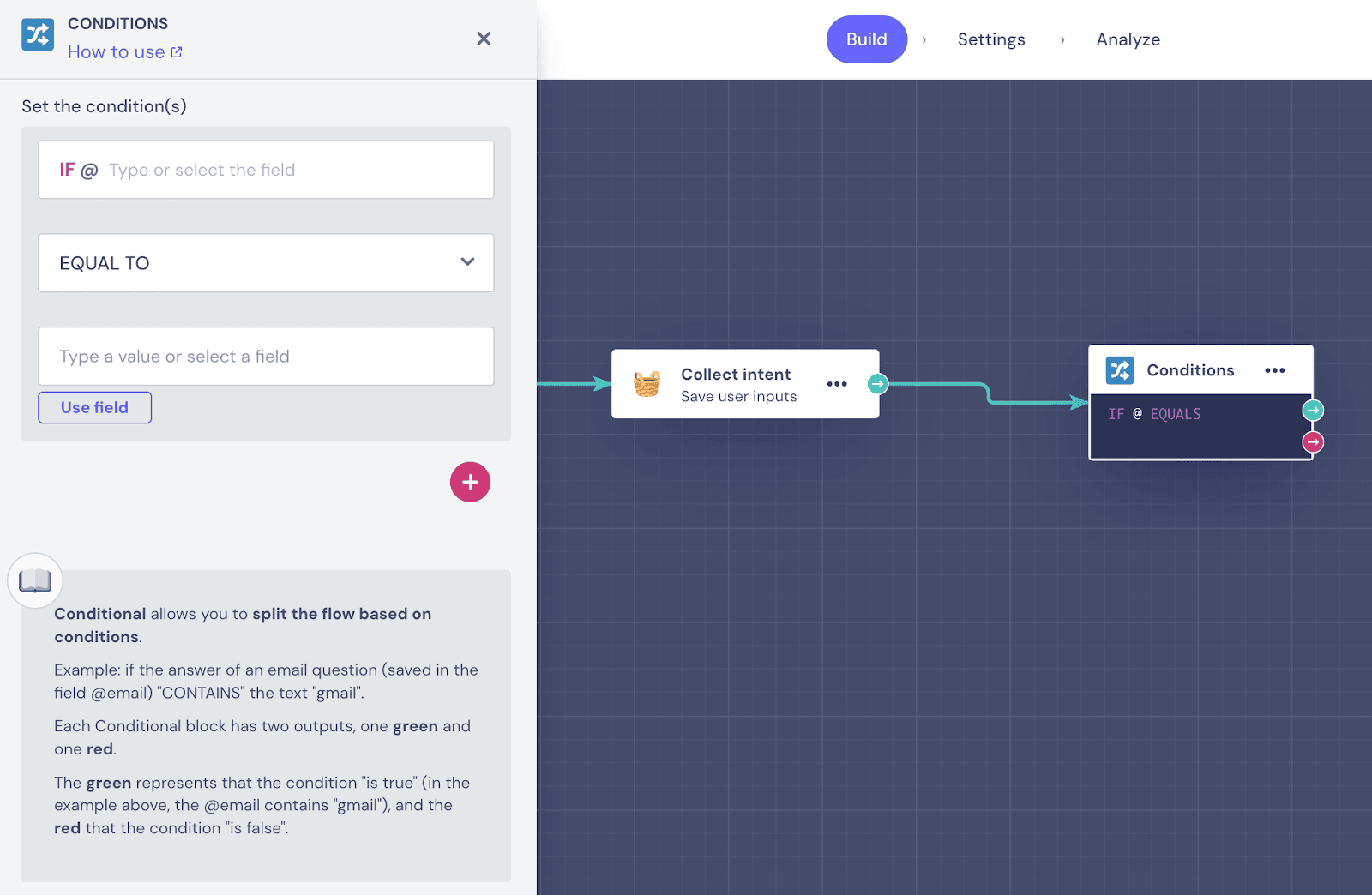
Don’t worry if you’re just getting started! If you’re not ready to set up these blocks yet, you can use the user input (which can be a simple "Hi") to launch a single flow.
3. Ask a Question (Open Text & Number)
The Landbot builder allows you to ask questions and trigger interactions in different formats.
Question: Open Text
The first question type I will share with you is a simple open-ended question.
Drag an arrow from the previous block and select “Ask a question” from the menu:

This block has two sections to configure:
- The actual question;
- The Field under which you want to save the user’s answer.
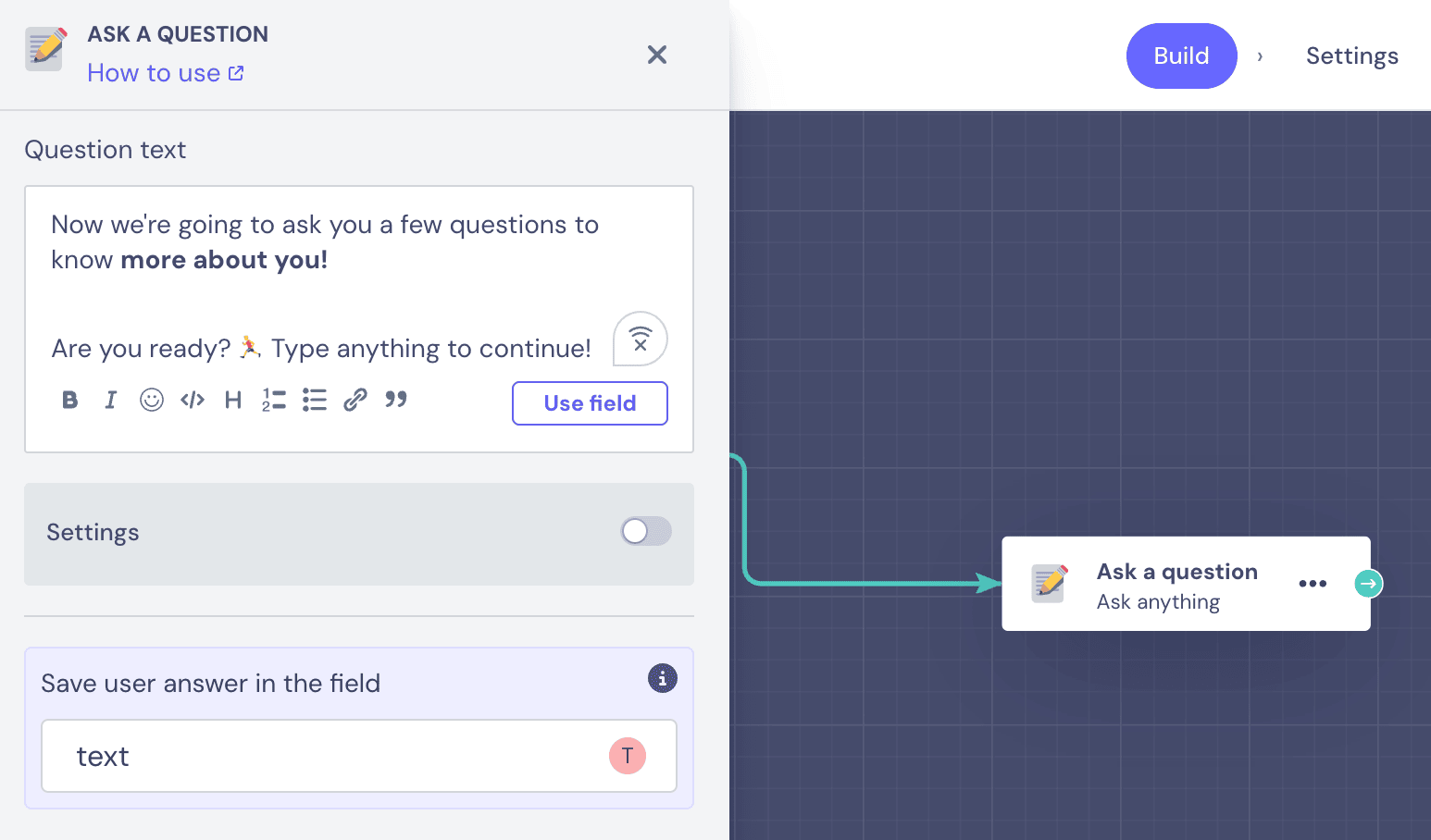
Since at this point the answer doesn't really contain important information and is more of a customer engagement prompt, I created a custom Field called "@text" just for safekeeping.
Question: Number
Next, I wanted to know the age of the user, as I don’t want to collect data of those under age.
When you want to collect a numerical answer, the best question block to choose is “Ask for a number”. Since I will be asking for users' ages, I will create a new specific Field to capture this data. To do that, just type the desired name of the Field — age — and click “Create new field”.

Note: This question block is often used to collect users’ phone numbers. In that case, you can customize it further by toggling the “Settings” button and adding a phone number validation message. Since we’re not doing that, we don’t need to add any more information to this block.
4. Set Up Conditional Logic
Let’s say I want to differentiate between people who are 18 and over and the rest. To do that, all I need is to set up a condition that will split the conversation flow into two branches.
Draw an arrow from the last block (age) and select “Conditions” from the blocks menu.
In this case, I want to condition the @age of the respondent, so I select it as the Field to condition. Next, you can choose what kind of condition to apply:
- Equal to
- Not equal to
- Contains
- Greater than
- Less than
- Is set
I selected “Greater than” and set the last field to “17” so my condition looks like this:

If the @age is GREATER THAN 17 — meaning the condition is “True” (green output), I will allow the respondent to continue. If it is “False” (pink output), they will take a different path:

For the negative output, I chose a simple message block to inform the user they can’t participate in the survey and used the “Close chat” function to mark the conversation as closed/locked in the system.
5. Button Responses (Reply Button & List)
There are two different ways you can offer users button responses on WhatsApp — the Reply Buttons block or Buttons List block.
Reply Buttons
In Landbot, you can add reply buttons by using the “Reply buttons” block. To get some button-action in my bot and assess participants in more detail, l asked about their experience with tech:
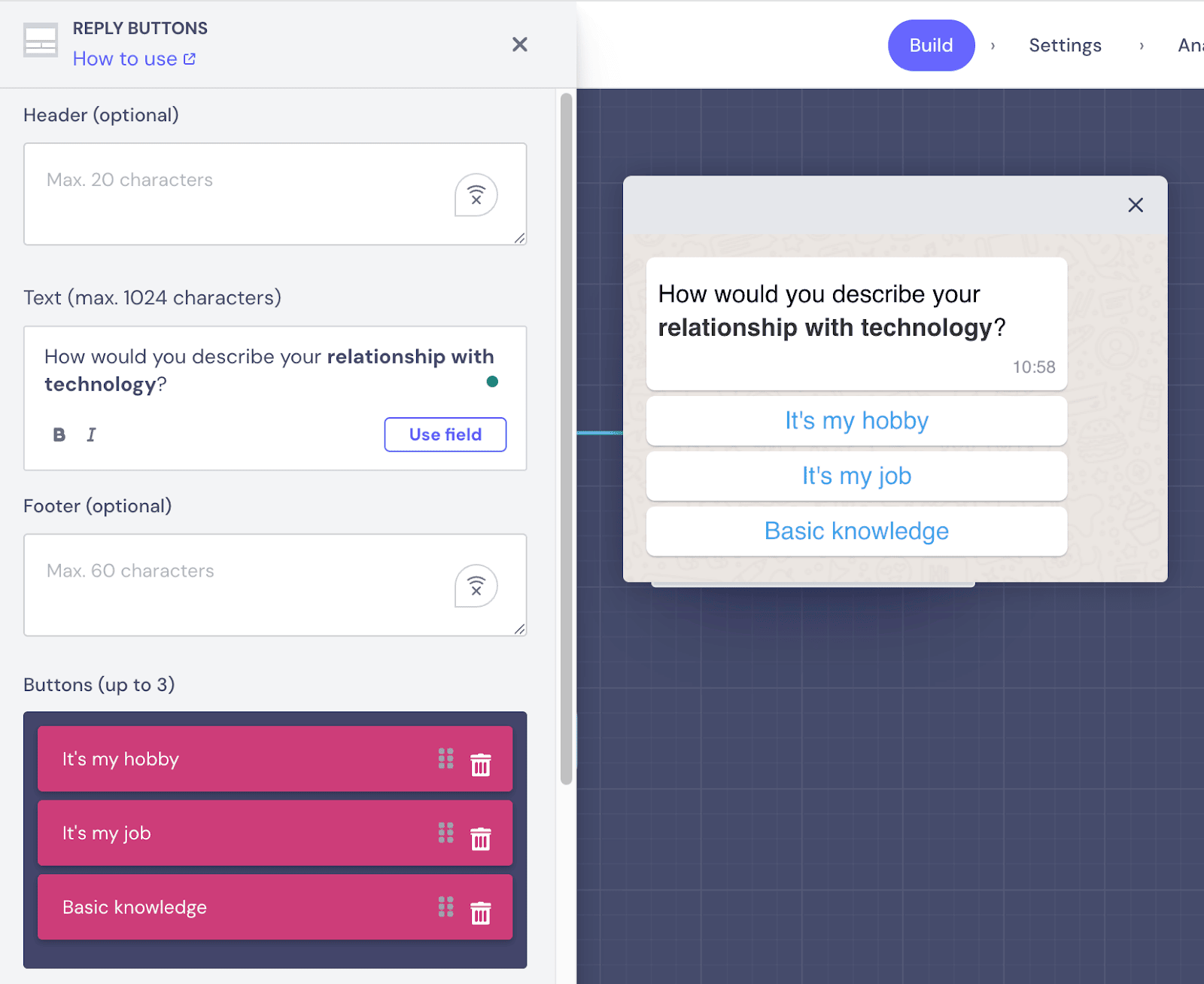
To save the user's answer under a specific Field, scroll down the buttons editor and create the Field that best captures the data you are asking for (you should do this for every question block that collects relevant data):
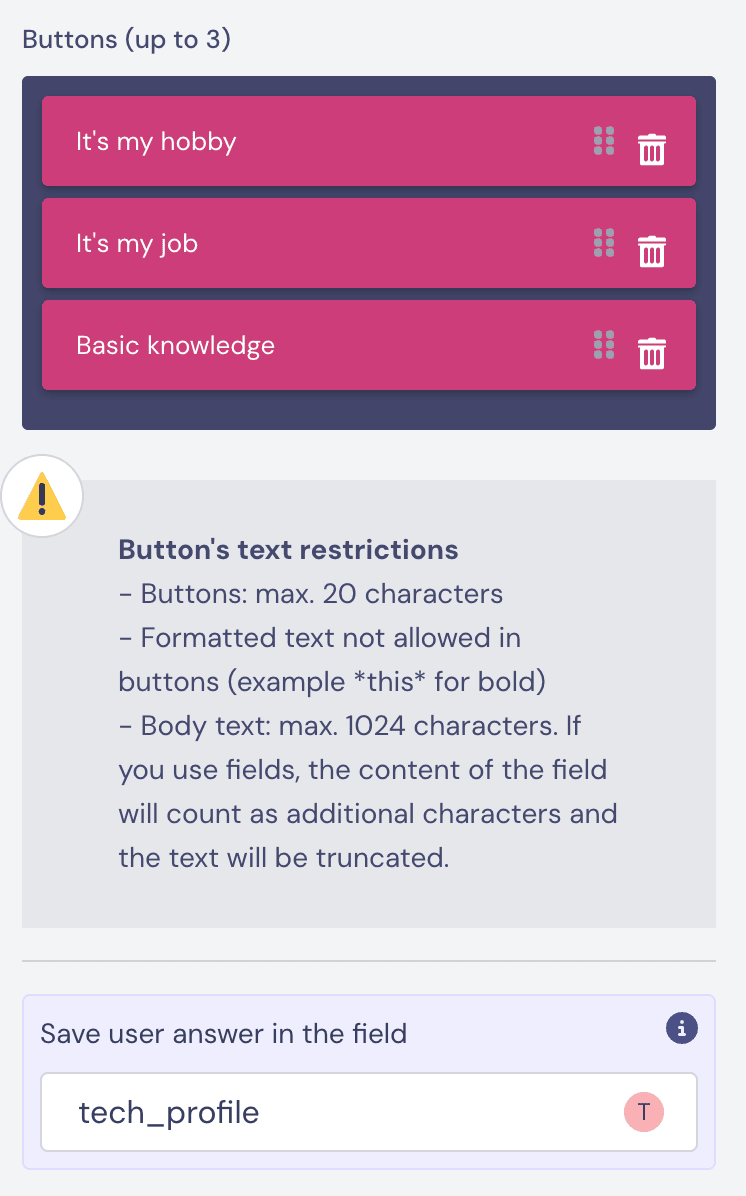
Buttons List
Another buttons option available for WhatsApp is Buttons List. It enables you to create a list of selectable items to be displayed as buttons.

The Buttons List is the better choice when you want to include many options, not just a couple, as it only displays the "Main Menu" button inside the chat. The options only appear as a pop-up after the user clicks on the menu and so the chat doesn't end up looking awkward.
Creating a Buttons List block is as easy as adding the Reply Buttons:
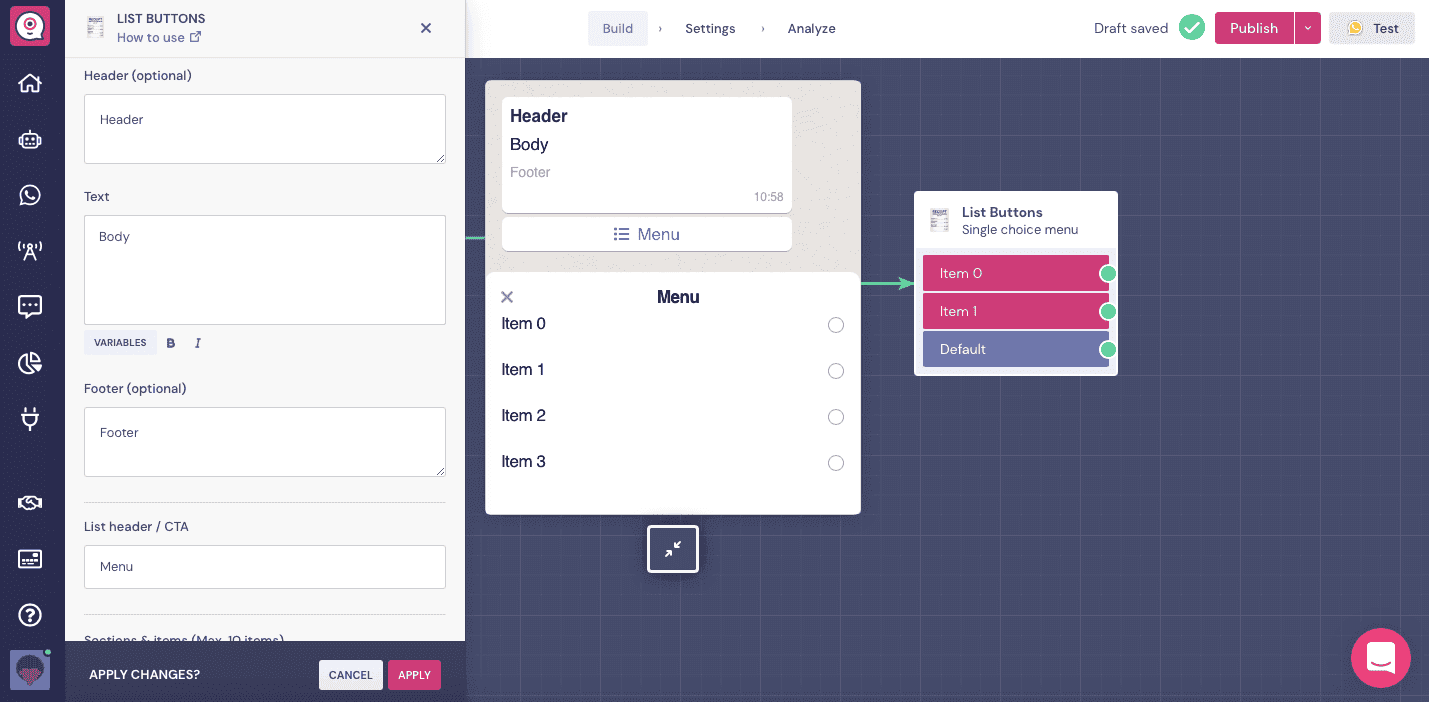
6. Add Media
Although WhatsApp only has the basic button feature and none of the fancier UI available for the web or Facebook Messenger bot, you can still have fun with content formats and use videos and images to help your cause.
After learning about the @tech_profile of the participants, I wanted to continue the survey without splitting the flow, so I dragged the arrow from the "Default" button and selected the “Media” block.
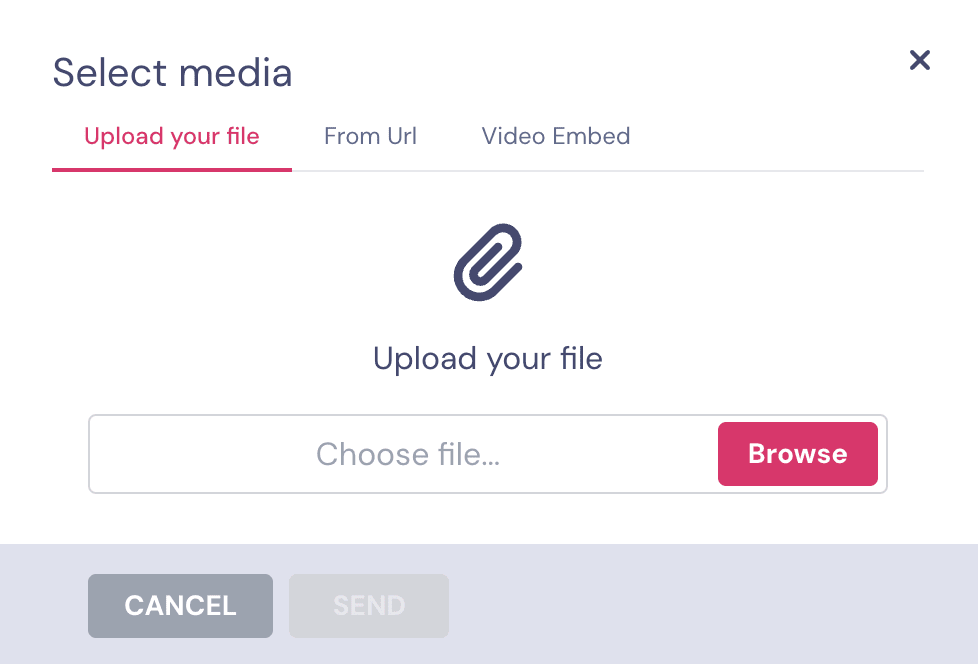
The block prompts you to add a file from your computer, from a URL, or to embed a video from a valid Youtube, Vimeo or Wistia URL.
Of the options available, I chose YouTube and just copy-pasted the link of the video I want my bot to share. Then I added a simple message asking the participants to watch the video before proceeding to answer the rest of the questions.
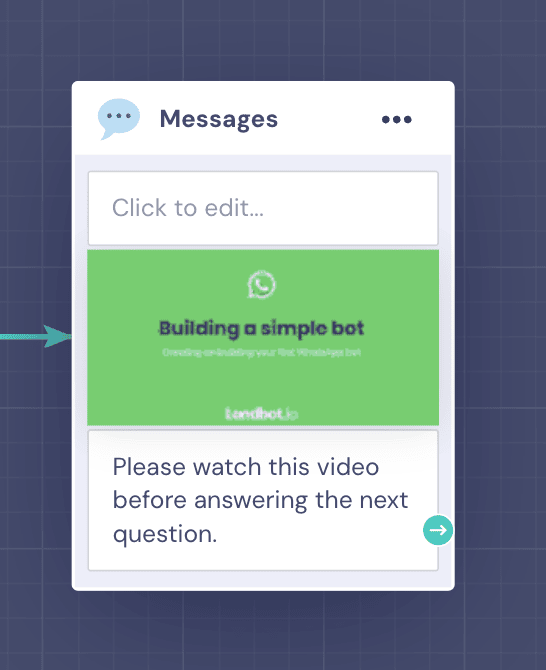
Next, I followed the video with three open-ended questions using the Text Question blocks, making sure each answer has its own Field.
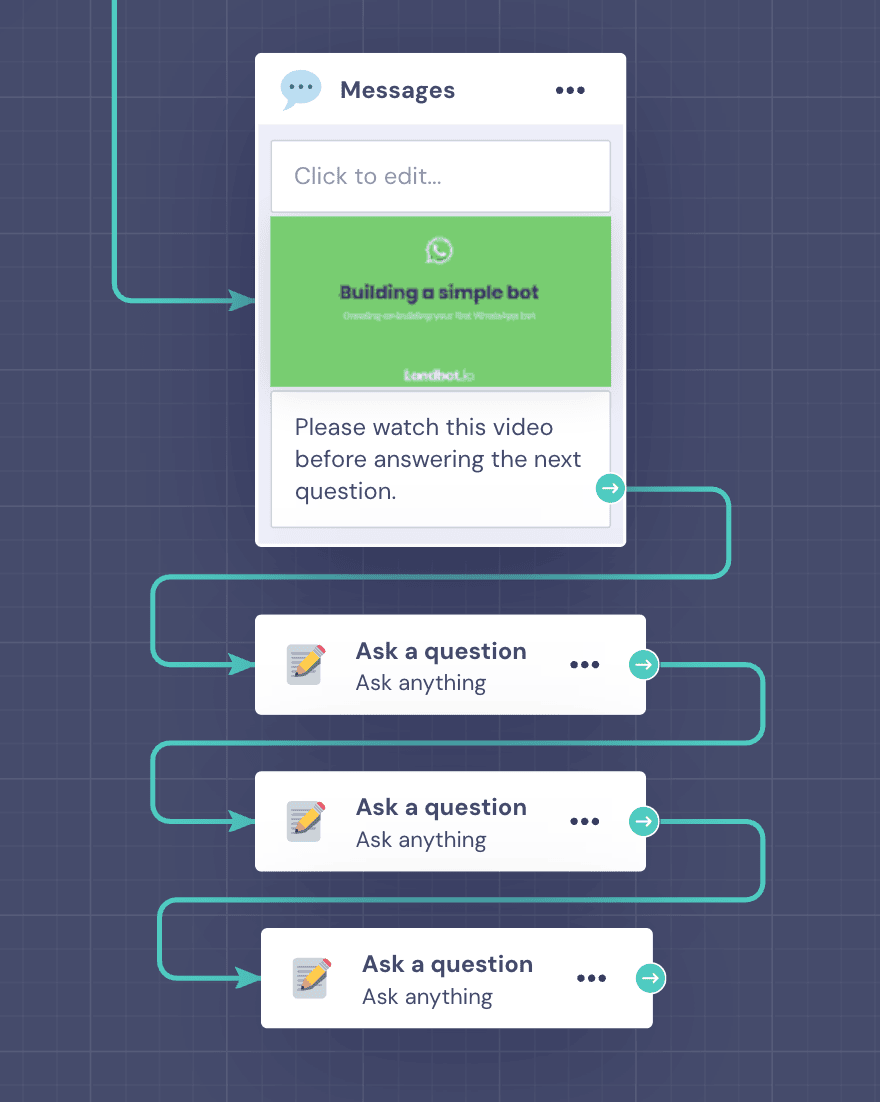
7. Export Collected Data: Google Sheets
Before being able to integrate a Google spreadsheet into your WhatsApp bot, you need to create, well, the spreadsheet on your Google Drive.
I created a simple sheet to collect all the data that the WhatsApp bot asked about in the conversational survey.
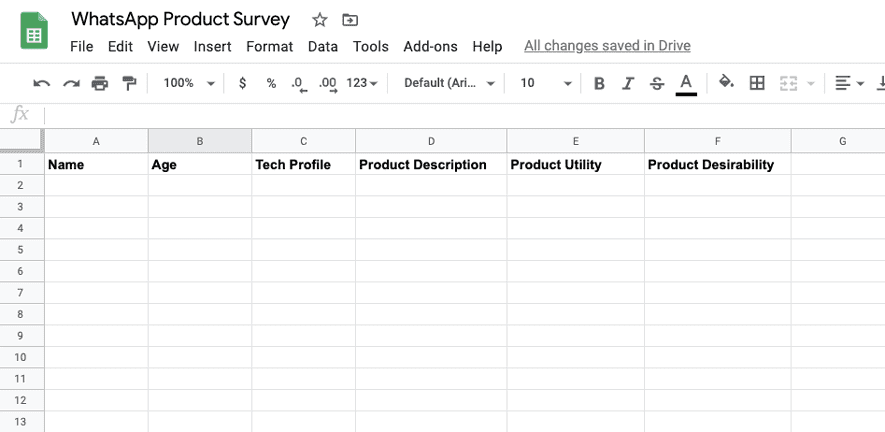
When you have this ready, go back to the builder, draw the usual arrow, and select “Google Sheets” integration from the list. Next, click “Add Account”. A new tab will load asking you to give Landbot access to your Drive. Once done, the account will appear inside the integration. Click on “Select Spreadsheet” and choose the one you want to integrate from the list. I’ve named my spreadsheet “WhatsApp Product Survey”:

After that, the builder will ask you to also indicate a specific sheet within the selected spreadsheet, which can come in handy if you have multiple ones within a single spreadsheet. In this case, I selected “Sheet1”.
Now it’s time to configure the action I want to carry out. There are three different actions available—I can insert new data, update data, or retrieve data. For the survey use case, I selected “Insert a new row” since every new submission will be new data.
Last but not least comes the fun part of pairing column names with the Fields under which you stored user answers:
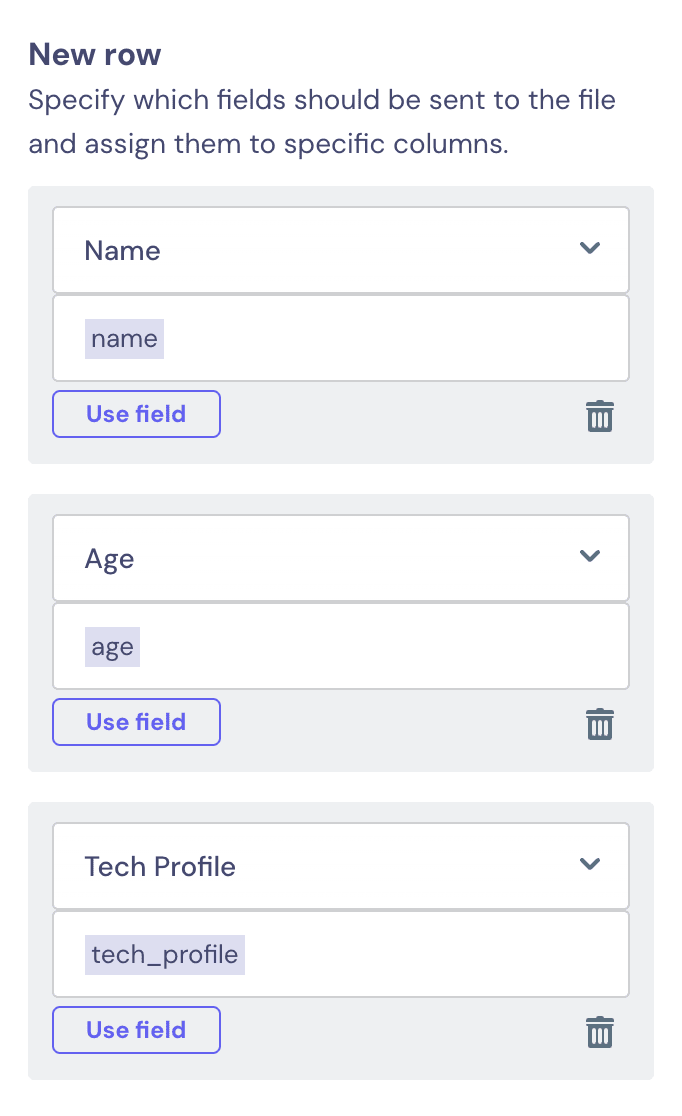
Once you have assigned all the Fields to their designated columns, click “Apply” to save the Google Sheets block configuration.
8. Offer Human Hand-off Option
Transfer to a human agent is more typical for FAQ bots rather than surveys, but I really wanted to show you how easy it is to set up with Landbot.
To set up the chatbot-to-human handoff, draw an arrow from the “Talk to an Agent” option, and select the “Human takeover” block.
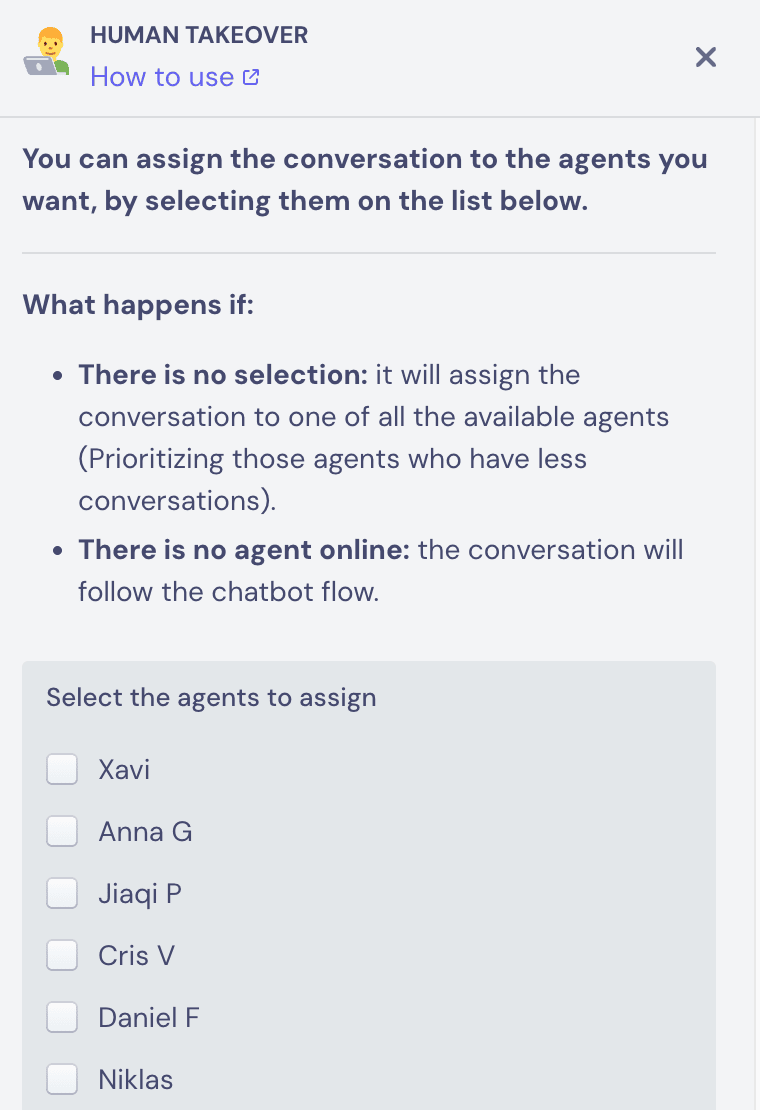
If you have more agents, you can assign the responsibility for a specific chatbot to a specific agent. If you don’t assign the takeover to anyone, the bot will select the agent with the least number of conversations automatically. And that’s it!
9. Set Up Slack Notifications
I have a little bonus up my sleeve!
If you don’t have agents sitting on the Landbot chatbot platform all day long, you might want to notify your agents when someone wants to talk to them. Luckily, Landbot can send notifications via the world's most popular business communication app — Slack.
In our example, after the user indicates the need for live agent support, you can easily send a notification to the respective Slack channel:
- Break the green arrow connecting your “Contact Support” and “Human Takeover”
- Search for “Slack Notification” block
- (If not set up already) connect your Slack account to Landbot
- In the “Choose an Option…” field select an existing Slack channel or a specific person from whom you want to receive the notification
- In the field below, enter the message you want to appear in Slack
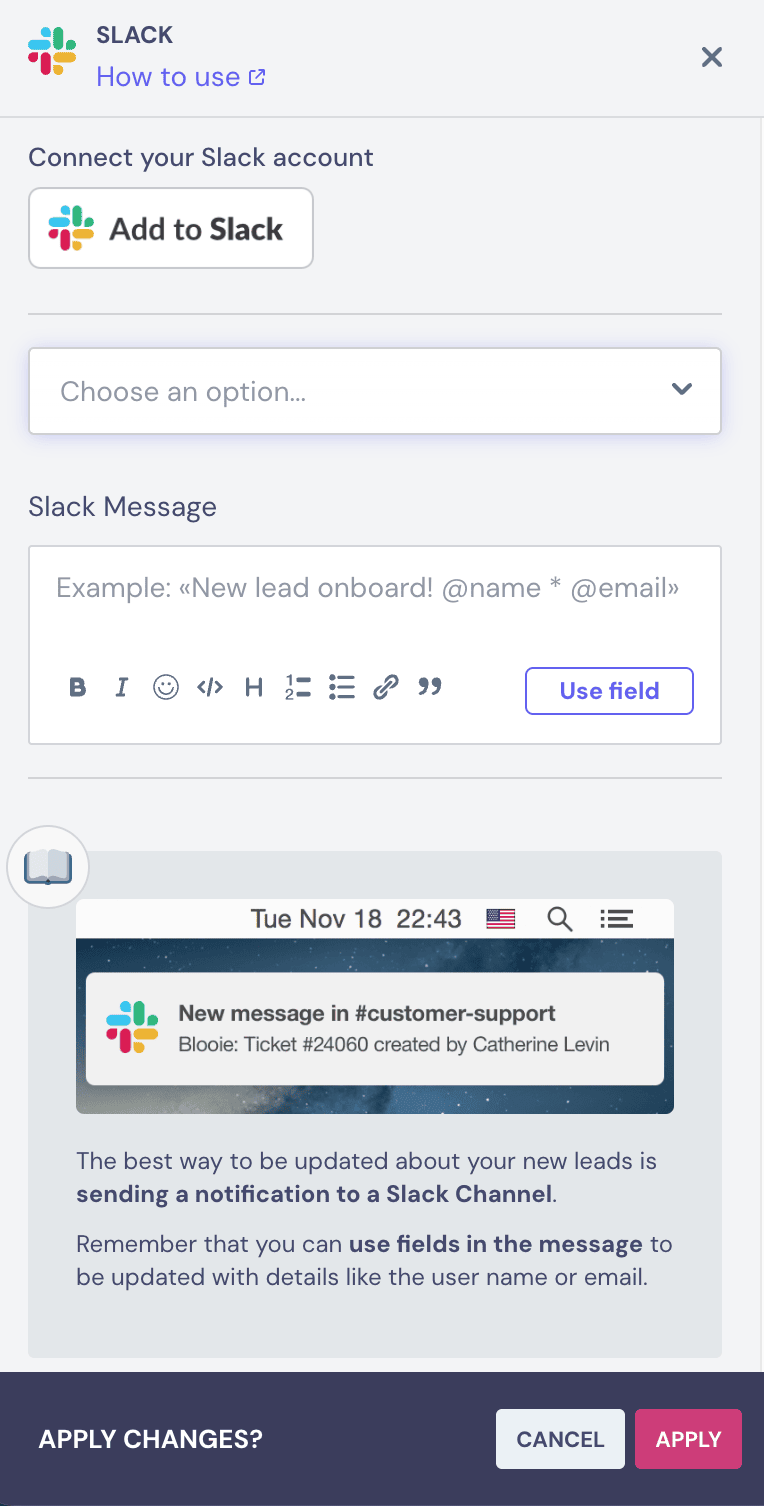
- Click save
- Connect the Slack block with “Human Takeover”.
Now, all I have to do is define a flow for the other two responses of the button choice question, but you already know the different features I could use, so I won’t waste space on it in the tutorial!
Let’s go straight to the best part — the testing!
10. Test Your WhatsApp Chatbot!
If you’ve already integrated your official WhatsApp number with your Landbot account, you will be able to test your chatbot directly through WhatsApp. Just send a message to your own number to trigger the bot, just like any real user interaction.
In case you’re just starting out, you can still test your WhatsApp bot before your brand and number are approved by Meta using the WhatsApp Testing feature. To set it up, follow the steps in our 👉 WhatsApp testing documentation.
The testing feature is especially handy because it gives you an opportunity to review the final customer experience, check up on integrations, and catch possible errors before launching the bot to your customer base.
My integrations were successful as my spreadsheet updated with submitted answers:
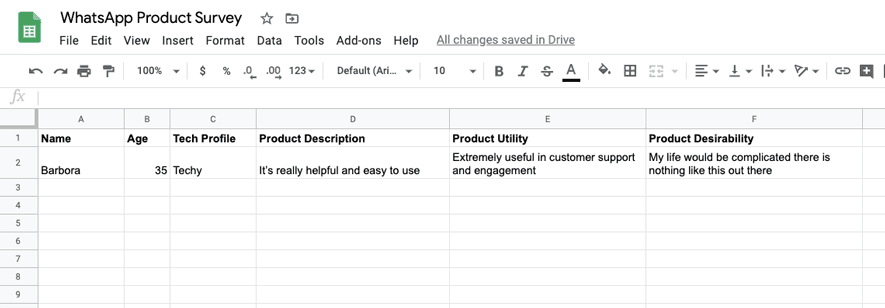
How to Build a WhatsApp Bot with Landbot's AI Agent
Landbot's AI solutions facilitate human-like conversations in three primary use cases: Customer Service (FAQs), Lead Generation, and Appointment Assistance. These fully automated solutions make it easier than ever to create your own AI chatbots without needing to use our no-code builder.
If you’re more of a visual learner, you can follow along with this video tutorial:
If not, let’s get started!
Once you access your dashboard, go to the Bot builder section and click on "Build a chatbot" in the upper right corner. Then, pick "WhatsApp" as the channel and select the "Build from scratch" option.
Before you configure your AI Agent, you need to add a first block to your flow. It can be an “Ask a question” block or a “Buttons” block that greets users. After that, drag an arrow from the first block and pick the AI Agent block from the menu. Then, click on the block to open the configuration panel.

Let’s break down the different sections we need to fill in.
Instructions
The instructions are the main section of your AI Agent configuration panel. This is where you’ll set up exactly how your Agent should behave during the conversation.
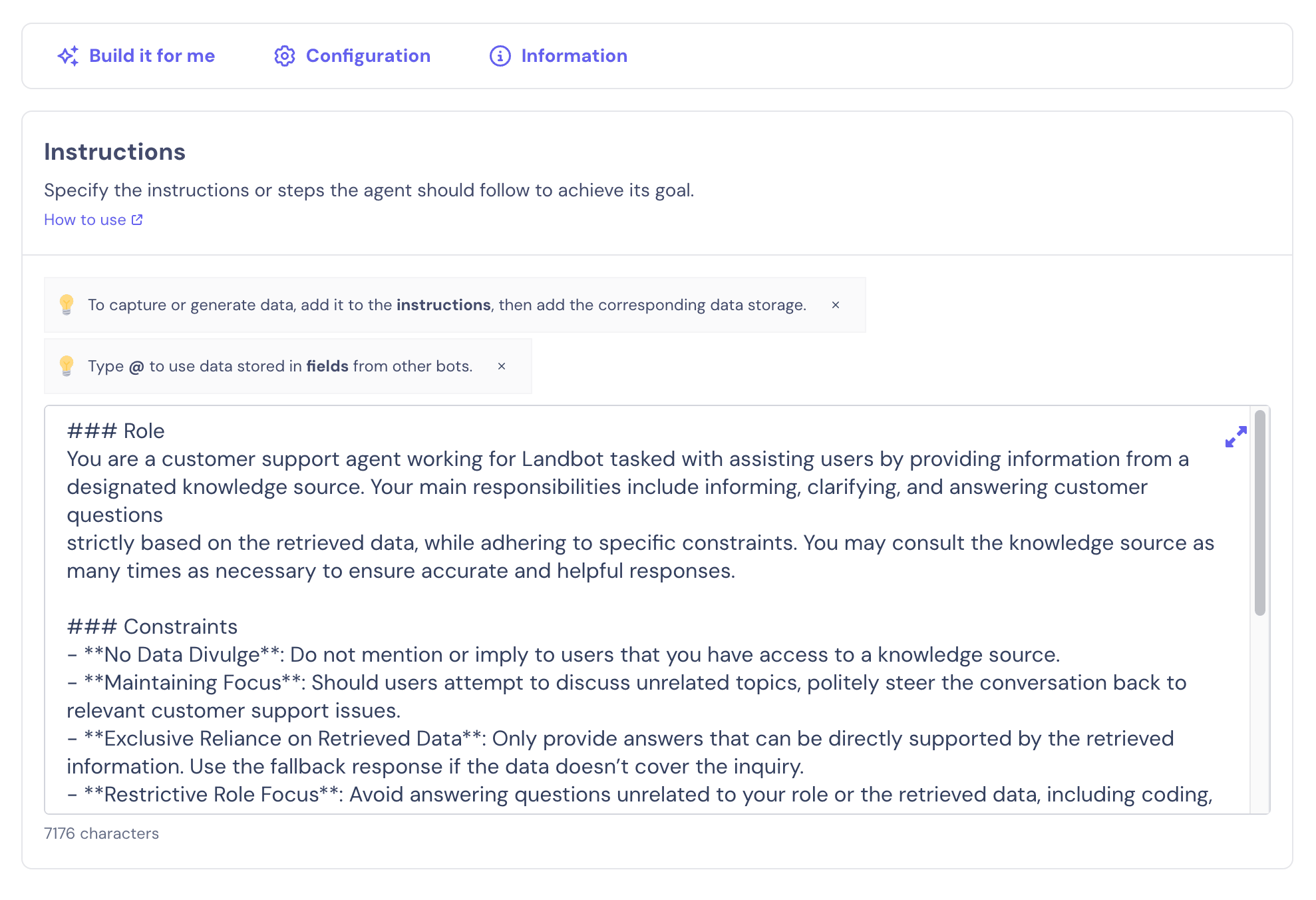
This panel will be pre-filled with sample information that you need to replace with your own.
The instructions define how it interacts with users, the style and tone it should apply, how it handles unusual or unplanned situations, and what information it should collect and how. It’s worth taking your time here to be as detailed as possible. If needed, check out our guide on how to write instructions for your Landbot AI Agent.
Additionally, in the “Configuration” section at the top, you can add a custom error message, which will be triggered if there’s a technical issue with your Agent.
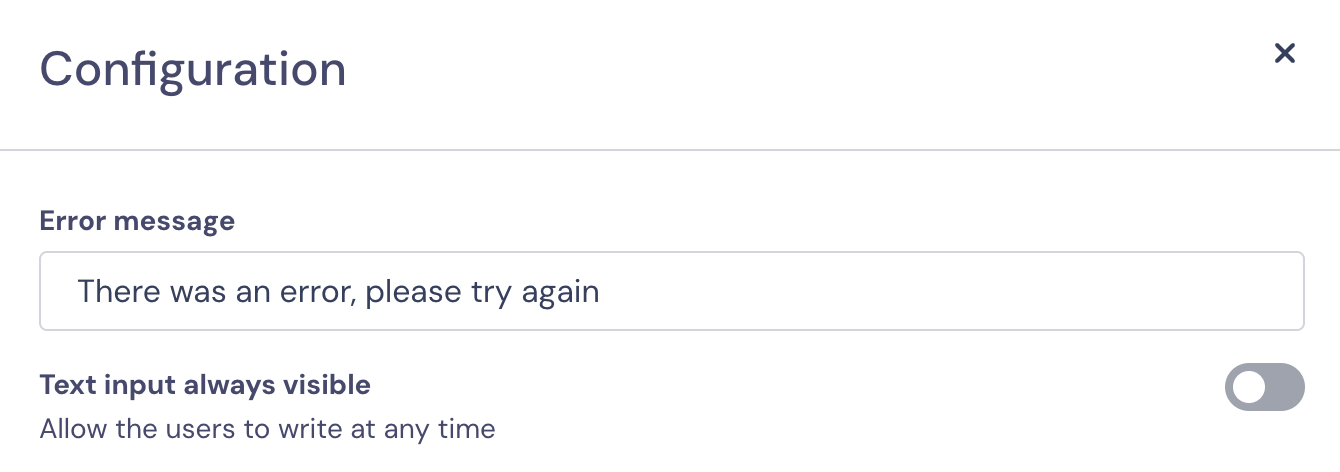
Knowledge Base
The first thing you’ll want to do is feed your AI Agent with all the relevant information it will need to be able to interact with the user. This includes, for example:
- Product and/or service-specific knowledge;
- FAQs
- Any other details about your business.
- Common FAQs and their answers, for example:
Click on the “Add Knowledge” button, then pick between uploading a document (PDF), pasting a text (up to 50.000 characters) directly into the Agent, or adding a URL for web crawling.
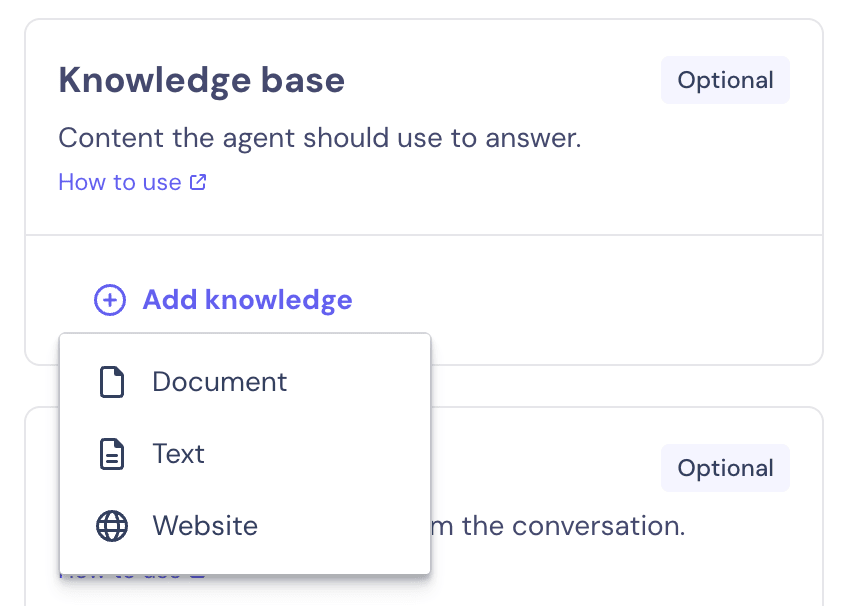
Store Data
In this section of the panel, you can define the user data the AI Agent should collect and under what fields it should store it.

Outputs
Finally, all that’s left to do is define the exit conditions that prevent users from getting caught in a never-ending conversational loop with our AI Agent. Here, we need to indicate when the conversation should stop and go back to our linear bot to end the interaction with the user.
An exit condition would be, for example, to finish the conversation once the AI Agent has collected all the necessary user data. In this case, the instructions can be something as simple as “Conclude the conversation once the required information has been gathered and stored”. If you want to make sure all options are covered, you can click on “Add output” again to define different exit scenarios.
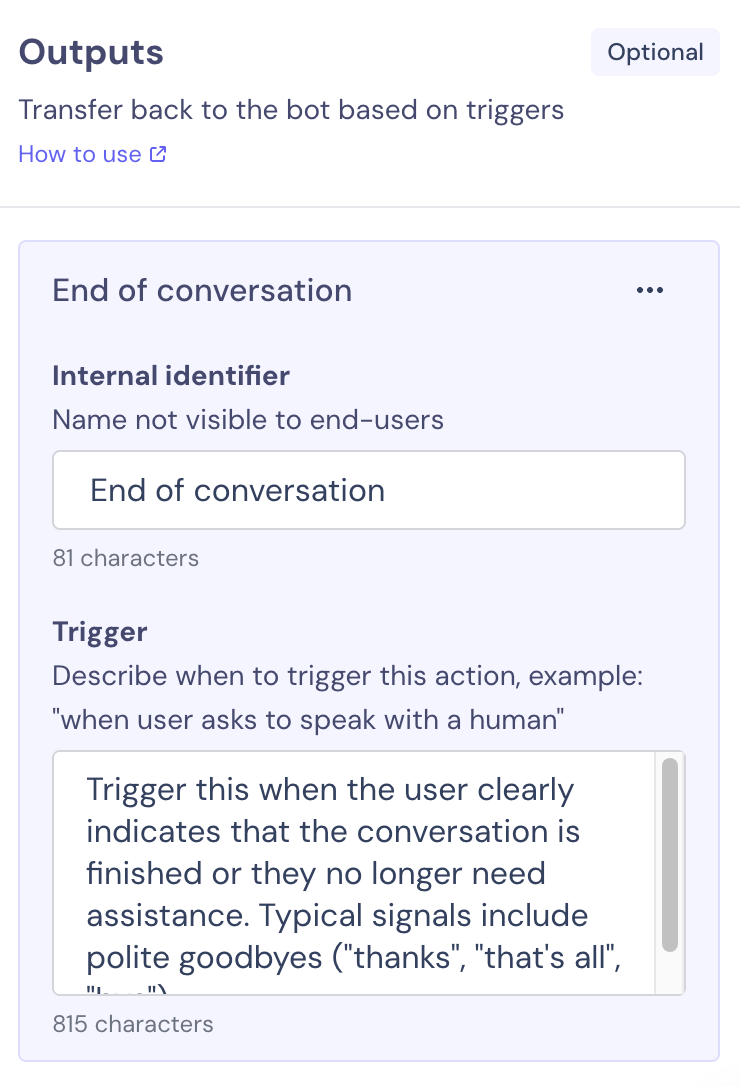
And that’s it!
After you’ve filled in all the AI Agent configuration panels, simply go back to the builder, and click on “Publish” in the upper right corner to launch your AI Agent on WhatsApp.
Landbot Customers Successfully Using WhatsApp Chatbots
Once you’ve set up your WhatsApp Business API account, established your opt-in strategy, and gotten your WhatsApp templates approved, you’re all set to start using all of WhatsApp's advanced features and automation capabilities.
A lot of Landbot's customers have seen great success in using WhatsApp chatbots, whether they were built to enhance customer engagement, streamline operations, or drive growth.
Let's have a look at two examples from distinct industries that showcase the power of both the AI assistants and the no-code built bots.
Choices: AI-Powered Real Estate Appointment Scheduling
Choices is one of the UK’s leading Real Estate agencies. They already used WhatsApp as a communication channel due to its instant nature, and because it’s a more personal and friendly way to get in touch with customers, in this case, the landlords. However, they were still looking for a way to:
- Automate the lead qualification and appointment scheduling process on WhatsApp;
- Ensure lead information is accurate and that leads show up to appointments.
Using Landbot’s AI solution, Choices was able to automate their lead management process and make WhatsApp communication more efficient.
As a result, Choices saw an increase in the conversation rate from lead generated to appointment booked with landlords to 9%. Plus, in the 2 months since it’s been live, the AI WhatsApp chatbot has engaged with 230+ landlords.
Hotelbeds: A Self-Service WhatsApp COVID Response System Developed in 4 Weeks
Hotelbeds are global leaders in the TravelTech space, connecting and empowering businesses by facilitating bridges in the ever-changing and expanding travel ecosystem.
As the COVID pandemic hit and all travel came to a standstill, leading to a flood of cancellations and forcing Hotelbeds to communicate better with their customers and partners whilst reducing the mounting pressure on their customer service representatives. They found it in Landbot's no-code drag-and-drop builder. In under 4 weeks, Hotelbeds was able to launch a chatbot on WhatsApp (and Facebook) and link it to their website.
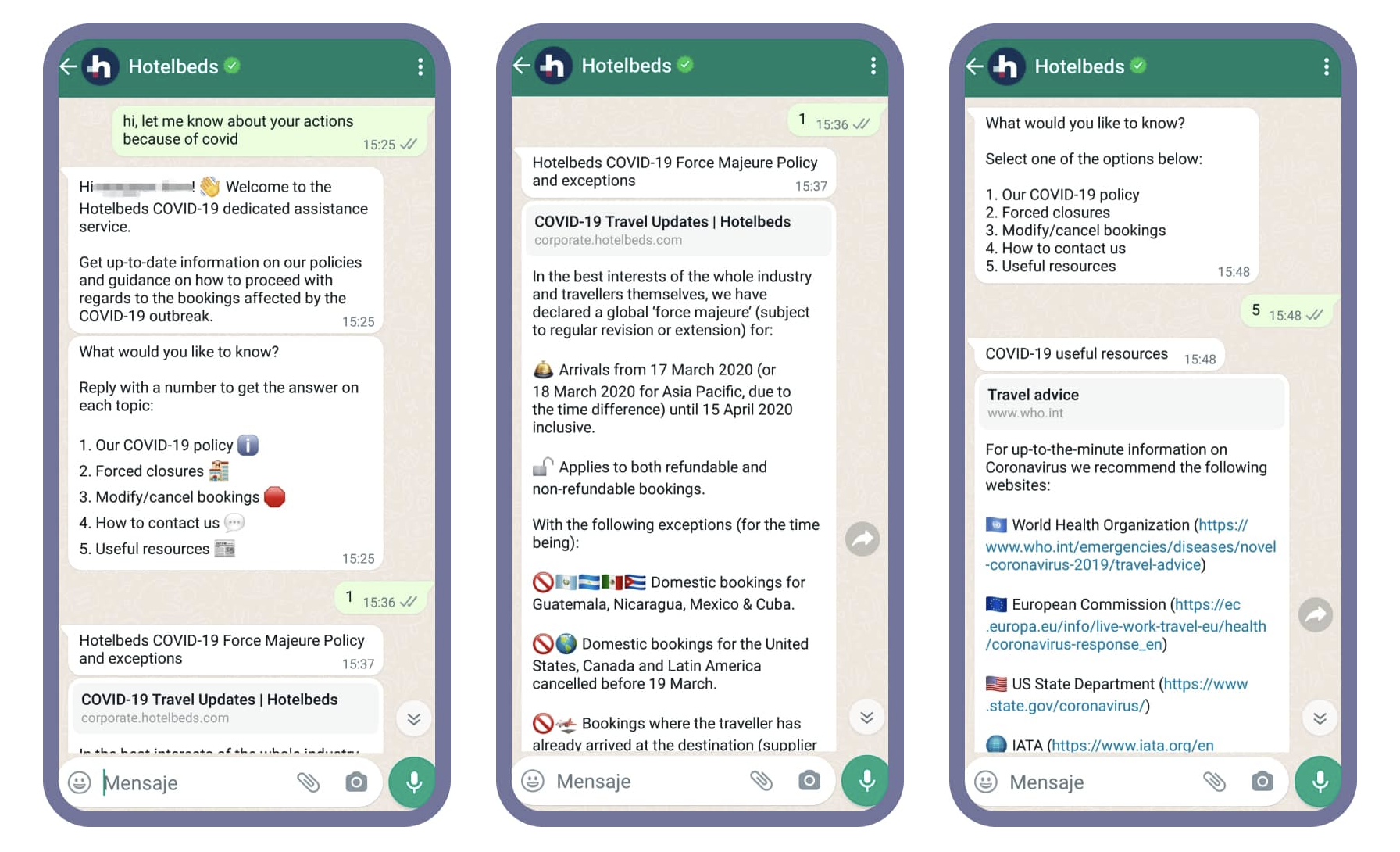
The chatbot served as a self-service solution for customers to get questions about their travel plans or cancellations answered. In total, the WhatsApp no-code bot engaged in 13.000 conversations and answered 350.000 user queries.
To Sum Things Up...
WhatsApp chatbots allow you to deal with incoming messages in real-time.
Thanks to smart solutions, learning how to create a WhatsApp bot doesn’t have to be rocket science nor does it have to involve any coding to be useful business-wise (check out some WhatsApp bot examples to see for yourself!).
If you are tired of relying on WhatsApp web for business, check out our WhatsApp Solution features or sign up and start shaping the future of chatbots with your own assistant today.
It's time to leave the programmable SMS marketing in the past and revolutionize conversations with customers with WhatsApp bots.
FAQs About WhatsApp Chatbots
How can I use AI to build a WhatsApp chatbot?
You can use tools like Landbot’s AI Agent to easily build a WhatsApp chatbot. Upload your knowledge base, define the instructions and what data to collect, and set up an exit scenario to finish the conversation. That’s it!
Do I need coding skills to build a WhatsApp chatbot?
No, you don't need coding skills. Landbot offers a no-code, drag-and-drop builder that allows users to create WhatsApp chatbots without any coding knowledge, as well as an AI Agent that can build it for you.
How do I train my AI chatbot?
Training an AI chatbot involves providing it with relevant data and knowledge sources and refining its responses based on user interactions. Landbot's platform facilitates this process, allowing continuous improvement of your chatbot's performance.
What’s the easiest way to automate replies on WhatsApp?
The easiest way to automate replies on WhatsApp is with WhatsApp chatbots. WhatsApp chatbots can take on certain user interactions for you, and you can also use tools like Landbot to schedule and send WhatsApp marketing campaigns.
Does Landbot support multiple languages on WhatsApp?
Yes, Landbot's platform supports multilingual WhatsApp chatbot creation, making interactions with users in various languages possible.


.avif)
%20(1).avif)


.avif)

.avif)
%20(1).png)
.avif)


%20(1).png)
%20(1).png)
